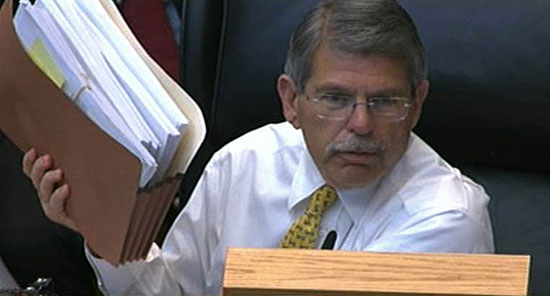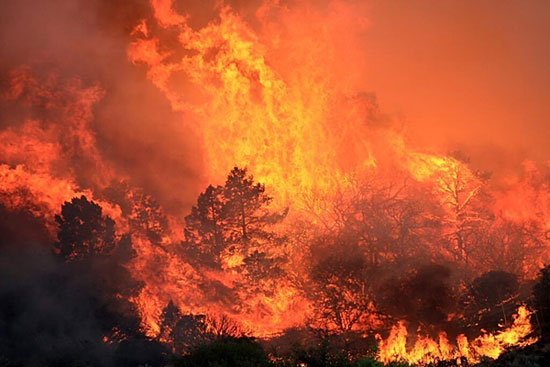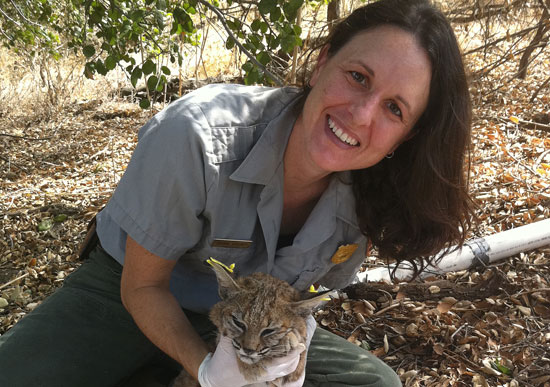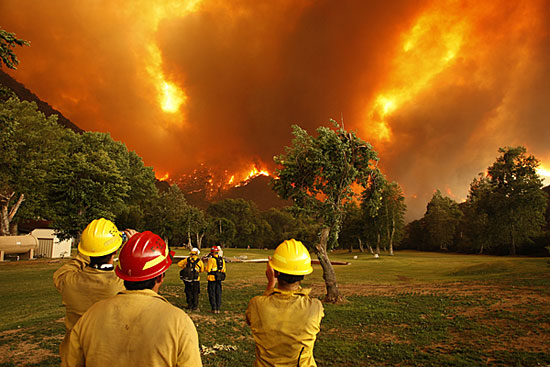Moving to fix a “broken” AB 109 system
June 27, 2013

A fatal stabbing on Hollywood's Walk of Fame is latest high-profile crime allegedly committed by AB 109 inmates.
Since its passage by the state legislature in 2011, AB 109’s radical reshaping of California’s criminal justice landscape has presented one challenge after another for the people and institutions of Los Angeles County.
The law, triggering the controversial process known as “realignment,” transferred responsibility for post-release supervision of state inmates to California’s counties.
Thousands of former state inmates have flooded into Los Angeles County under the program. Although the crimes that landed them in state prison prior to their release were supposed to have been so-called “non-non-nons”—non-violent, non-serious, non-sexual offenses—these inmates often have an earlier record of far more serious crimes.
The fatal stabbing of a 23-year-old woman on Hollywood’s Walk of Fame, allegedly committed by AB 109 inmate Dustin James Kinnear, a panhandler with a long history of criminal offenses and mental illness, is just the latest incident to spark widespread outrage.
Led by Supervisor Zev Yaroslavsky, the Board of Supervisors this week launched an intensive review of what happened from the time Kinnear was released by the state until the moment he encountered the victim, Christine Calderon of Lynwood, on Hollywood Boulevard on June 18. Supervisors also directed the county departments with the greatest AB 109 responsibilities—Probation, Mental Health, Public Health and Sheriff—“to determine whether current laws or procedures are adequate to protect against any of the possible gaps” in the AB 109 process.
“The system is broken. It needs to be fixed or it’s inevitable that there will be more Christine Calderons up and down the state of California,” Yaroslavsky said after the motion was adopted. “Common sense says that this man should never have been released as early as he was from prison, and should not have been released under AB 109 in the way he was.”
Calderon’s murder is the latest in a high-profile string of crimes allegedly committed in L.A. County by AB 109 inmates.
Inmates released by the state who went on to allegedly commit heinous crimes in Los Angeles County include Ka Pasasouk , the accused gunman in last year’s quadruple homicide in Northridge, and Tobias Dustin Summers, arrested and charged with the kidnapping of a 10-year-old Northridge girl in March.
An analysis of the first year of AB 109 releases in the county, reported on Supervisor Yaroslavsky’s website, found that more than 30% of the 11,000 inmates placed under county supervision during the year were rearrested for crimes including 16 murders, 23 attempted murders and 205 robberies, along with other less serious crimes.
Officials have emphasized that AB 109 is not an early release program, and say that the inmates would have been released from custody and into their home counties in any case, where they could have committed the same crimes regardless of whether they were being supervised by state or county authorities.
Yaroslavsky, who has long voiced concerns about the program, said that, like it or not, AB 109 inmates will continue to come under L.A. County’s supervision so it’s essential to find ways to improve the process going forward. Among other things, he said, detailed and meaningful mental health information must be provided to the county early enough so informed decisions can be made to protect public safety.
“Locally, we have to make sure that we’re doing everything we can and that people aren’t falling through the cracks when they do become our responsibility,” Yaroslavsky said. “We’ve got to know what went wrong in order for us to avoid this tragic outcome in the future.”
Posted 6/27/13
Grand patriotism for Independence Day
June 27, 2013

Workers this week were busy sprucing up downtown's Grand Park for its inaugural 4th of July celebration.
Surrounded by iconic government buildings and carefully planted with diverse flora from around the world, downtown Los Angeles’ Grand Park isn’t the ideal place for the fiery explosions typical of big Independence Day events. So park staff had to get creative for the upcoming 4th of July Block Party.
“We’re kind of limited in the kind of fireworks we can shoot off,” said Julia Diamond, Grand Park’s programming director. “We have a beautiful park and architecture, so we want to be extra careful.”
For the past three months, Diamond and her staff have been meeting regularly with Los Angeles Fire Department officials to come up with a way to have a fireworks show that will still bring plenty of oohs and aahs. Traditional rockets that explode hundreds of feet in the air were ruled out; they leave behind burning shells that require a fallout zone to prevent fires and keep people safe.
Luckily, this is Tinseltown, where special effects and pyrotechnics are serious business. A local company, J.E.M. FX, was tapped to design a display suitable for the venue’s first-ever Independence Day celebration. They plan to use “proximate pyro” effects, designed to dazzle crowds at close range. Ron Smith, vice president of theatrical operations for the company, said the show will be similar to those you’d see at the Super Bowl or a music festival. The lack of big rockets won’t make it any less impressive, he said.
“It’s more up-close and personal,” Smith said. “You can design effects close to the music beats—because it’s close to the ground you can choreograph better.”
The fiery display will take place on the park’s middle block by the Court of Flags. Guests can spread blankets on both sides of the show, either on the grassy block in front of City Hall or the block in front of The Music Center, where the restored Arthur J. Will Memorial Fountain is located and where most of the night’s other entertainment will take place. The fireworks display will last about 10 minutes and use about a thousand different effects.
The brand of pyrotechnics won’t be the only non-traditional entertainment. As part of its continuing celebration of L.A.’s diversity, “the park for everyone,” as Grand Park bills itself, will avoid things like the 1812 Overture or the pomp of John Philip Sousa. KCRW DJ Anthony Valadez will spin globally-influenced dance music and L.A.-based artists Ethio Cali and Jungle Fire will perform live world music. Young slam poetry stars from Get Lit will perform at the event, too, as they brush up for national competition.
Of course, no outdoor event in L.A. is complete without gourmet food trucks. Game On Gourmet and the Rollin’ Rib BBQ Joint will be among the culinary fleet stationed at both ends of the park.
The music starts around 4 p.m. and the pyrotechnics will begin around 9 p.m. Parking is available at the Music Center and other lots, but the best bet may be to take Metro’s Red Line to the Civic Center/Grand Park station. Visitors who bring their TAP transit pass can pick up a free pair of Grand Park sunglasses at the information booth.
For organizers like Diamond, major holiday events like this are an opportunity to realize the park’s mission.
“The 4th of July is a chance for Grand Park to fulfill the role it was designed to play in this city,” said Diamond. “Grand Park is meant to be the civic heart of L.A.”
Posted 6/27/13
Toward a more perfect union
June 26, 2013
All of us—gay or straight, male or female, young or old—achieved an important victory at the U.S. Supreme Court this week, one that speaks to our common humanity in profound ways.
The most obvious beneficiaries of the court’s rulings Wednesday on same-sex marriage are gays and lesbians seeking the right to marry the person they love.
But the court’s essential message was this: Equal justice under the law applies to everyone in our society, without regard to race, religion, sex or sexual orientation. And as such, the court’s decisions are a victory for equal rights for all Americans.
This was especially true in the court’s decision striking down the Defense of Marriage Act, making clear that gays and lesbians are entitled to the same constitutional protections as everyone else. Its action on California’s Proposition 8 was narrower but no less significant, ensuring the right of gays and lesbians to marry here in the nation’s most populous state.
Although more court challenges undoubtedly lie ahead, change is coming—in a big way—as more states join the 13 now recognizing same-sex marriage and the Supreme Court heads inevitably toward a future case that will provide the perfect vehicle for affording this basic constitutional right to all Americans.
The court’s actions this week reflect the swift and remarkable evolution of public attitudes on gay rights and same sex marriage. I can’t think of another issue in my lifetime where we’ve moved so far so fast. The victories of the civil rights movement took generations to achieve but this time, I think, we’re on a quicker pace toward justice.
We’re growing into a more tolerant nation, a nation that believes in live and let live. Millions have figured out, as I did, that heterosexual couples aren’t harmed in any way by same-sex marriages.
Starting now, we can also put to rest a troubling chapter in our state’s history, in which an attempt was made to use California’s constitution to diminish rights, rather than expand them.
As I and others argued during the campaign against Prop. 8, the constitutions of the United States and California have always been used as tools of inclusivity, of empowering people and affirming rights—not for excluding people or exempting them from equal protection.
This vitally important principle has been upheld.
Still, there were disappointments in the high court’s rulings, starting with the 5-4 votes in both decisions.
It’s disheartening that, well into the 21st century, key constitutional rights were upheld by only the slimmest of Supreme Court majorities.
Also, instead of boldly creating a national precedent by ruling Prop. 8 unconstitutional, the justices took a technical way out. They let stand a lower court’s ruling striking down the measure by determining that Prop. 8 proponents weren’t legally qualified to make the challenge.
But imperfect results can still be powerful. As I’ve said before, Ty Cobb only batted .400 and he’s in the Hall of Fame.
And these rulings taken together constitute a giant step forward in our republic’s journey to a more perfect union.
Posted 6/26/13
DCFS under microscope again
June 26, 2013

Supervisor Yaroslavsky, arguing against a new commission, says now is the time for action, not more recommendations. Here, he displays five years worth of board motions to examine DCFS operations.
Faced with another controversy over the failure of social workers to remove a child from a dangerous home, a divided Los Angeles County Board of Supervisors this week approved the creation of a blue-ribbon panel to investigate the Department of Children and Family Services and recommend reforms—the latest in a series of examinations stretching back decades.
The board’s action, on a 3-2 vote, follows the death last month of 8-year-old Gabriel F. of Palmdale, who was allegedly tortured by his mother and her boyfriend, both of whom are being held on murder charges. Social workers had earlier received multiple reports of abuse and neglect involving Gabriel, only the most recent child fatality to generate headlines and public outrage over the years.
The push for an independent panel came from Supervisors Mark Ridley-Thomas and Michael D. Antonovich and is modeled after the Citizens’ Commission on Jail Violence, which last year recommended dozens of reforms to curb brutality by sheriff’s deputies assigned to the county lockup. Its members, who included former judges, prosecutors and a prominent pastor, were appointed by the Board of Supervisors, who’ll also pick the new panel.
During Tuesday’s meeting, all five supervisors expressed deep frustration over the tragedies that have continued to plague DCFS and have prompted numerous management shakeups and hundreds of recommended reforms from oversight bodies. But the supervisors broke ranks on how best to achieve the foremost goal of keeping youngsters safe, with Ridley-Thomas, Antonovich and Gloria Molina voting for the commission and Zev Yaroslavsky and Don Knabe voting against it.
The proponents argued it was time for a fresh look by a group of independent, highly-respected individuals, who’d be given the authority to examine not only DCFS but other local agencies with which it interacts. The opponents, meanwhile, argued that DCFS’s director, appointed a little more than a year ago, already has made strides—including the adoption of a new strategic plan and training curriculum—and should not be distracted from the job at hand at a critical moment for the department.
Here are condensed excerpts of what each had to say, along with the edited remarks of DCFS Director Philip Browning:
Mark Ridley-Thomas
“Since 2008, there have been over 100 motions on our respective parts. Our collective effort is well documented. But when the time comes to turn our collective will into effective actions, unfortunately we have fallen short. There are times when government is unable to transcend a stagnant set of circumstances. Status quo needs to be altered. And so by establishing a blue-ribbon commission, we can finally get down to why these recommendations have not been implemented and understand what needs to be done. The commission is not intended to re-invent the wheel. Rather, the intent is to get the wheels turning and DCFS and related agencies moving forward. The blue ribbon commission will serve a very distinct role. Some have argued that we already have a children’s commission, so there’s no need for a blue ribbon commission. I would just simply say commissions can and do make governance more dynamic. They are less likely to be politicized and more inclined to be singularly focused, clinical in their pursuit and, therefore, have the opportunity to add significant value… particularly for this population that is so clearly vulnerable.”
Zev Yaroslavsky
“There isn’t a member of this board that doesn’t care deeply about the children who are our responsibility. Nothing makes me more angry than to see a child suffer anywhere, whether it’s in L.A. County, or on my block or in any part of the world. But the question is: how do you get it done? I can almost verbatim tell you what the commission report will say: ‘You’ve got to hire a lot more social workers.’ ‘You’ve got to have more accountability and more transparency.’ All of the kinds of things we have asked our current director to do. And we need at some point to let the current director breathe and do his work under careful scrutiny and accountability by the board. I’m, as many of you know, an adherent of John Wooden, the former UCLA basketball coach, who had a great line, among many great lines, which is: “Don’t mistake activity for achievement.” I think our challenge now is to execute what we know needs to be done. If we had never done this before, if there had never been a study of DCFS before, if there had not been a barrage of state audits before, had there not been a CSIU [investigative unit], then I would say a blue-ribbon commission is the way to go. But it’s ‘activity.’ And whether there’s achievement remains to be seen.”
Gloria Molina
“Very frankly, we’re not finding a solution [to child deaths]. And I wish it were just a problem in L.A. County. When you look at it across-the-board, whether you’re in Chicago, New York, San Francisco, you have the same issues: how to handle it and what we’re doing. There must be something that we’re missing. And so having a set of fresh eyes look at that is a good thing because I know I would be willing to accept a new set of recommendations. I really think that everything in that department has to change and has to change dramatically—everything from training our social workers to hiring our social workers to bringing accountability and, more importantly, to training our managers [who] in most instances can’t manage anything. But I applaud that we are moving forward in this direction. Until the blue ribbon commission concludes its review and analysis and this board acts upon its recommendations, it is the responsibility of this board…to immediately ensure this department continues to provide safety for children under their supervision.”
Don Knabe
“The minute something goes wrong, what do we do? We have another reaction to the media. We have another commission. We have another set of 99½ recommendations. Another rehash of everything we know that’s on the table. I think we’re all tired of hearing recommendations. We already know what needs to be fixed. We all want action and the greatest fear is that our department, DCFS, will come to a screeching halt because we are drowning in recommendations and losing that direction. And this blue ribbon commission would bring it to a total halt…What are they going to tell us that we don’t already know? After all the other recommendations and all of the advice that we have received over the years, what is sorely lacking is the refusal to set aside the many distractions and just get the job done. We must send a message as a board of zero tolerance of any action that exposes our children to harm. Another commission, I don’t think personally, will address those problems or set us on a path in the future. Another commission will just be a distraction to the very, very important work at hand.”
Michael D. Antonovich
“Just for the record, this motion [for a commission] does not inhibit the Department of Children and Family Services from moving forward with the implementation of their strategic plan and some of the most critical components, including the revamping of the training curriculum, policy manual rewrite and staffing reorganization. But what it does do is focus on a very serious issue and brings to a head the problem with recommendations.”
Philip Browning, director DCFS
“In my 40 years of public, private, military service, I’ve never turned down any help and I don’t intend to today. I do believe that there is some value in having a set of fresh eyes look at things. I know I learn something new every day. I do believe also that it’s critical that we have individuals [on the panel] who are knowledgeable, professional, independent, have no conflict of interest in order to really move this department forward. We’ve had some tragedies lately that are just unspeakable. We’re going through a process of investigations and hopefully we’ll get to a conclusion pretty soon. The most important thing I think I’d like to leave you with is that safety, in my opinion, is our primary goal. It’s job one for us. Frankly, most of the situations that don’t end up well don’t occur in foster homes or group homes. They occur when we’re trying to keep children in their families. And that is a very, very tough job. And it is one that they often don’t get thanked for.”
Posted 6/27/13
Let the “I do’s” begin—almost
June 26, 2013

Gay rights advocates celebrated outside the U.S. Supreme Court, which effectively nullified California's Prop. 8.
They set the alarm for 5 a.m., two hours before the U.S. Supreme Court ruling, and turned on their TV.
For four years, Cesar Hernandez-Topete and his partner, Miguel Topete-Hernandez, had been waiting. They’d rented an apartment together, launched a business together, applied to become foster parents together, even cared for their bulldog-terrier mix, Grace Kelly, together. Under the law, however, they couldn’t do the one thing they wanted most—to marry and spend the rest of their lives together.
So when the courts cleared the way on Wednesday morning for the resumption of same sex marriage in California, the Long Beach couple embraced in the morning light and celebrated the news together.
“It was really emotional,” says Cesar, 26, adding that he and Miguel had been hoping for an autumn or winter wedding. “We hugged and cried, and Grace Kelly was jumping around—probably because now she won’t have two fathers out of wedlock! I believe so much in our relationship and everything we’re doing together. I knew that one day, we’d be gratified.”
As Californians absorbed the significance of Wednesday’s rulings, local officials prepared for the rush back to the altar amid the demise of Proposition 8. In Los Angeles County, Registrar-Recorder/County Clerk Dean Logan said that much of the bureaucratic framework is already there, but that the county will be adding locations where couples can schedule civil ceremonies.
“This is a customer service issue for us,” says Logan, noting that a bevy of temporary chapels are being set up at the office’s Norwalk headquarters and in municipal buildings in West Hollywood and Long Beach. “We already have the infrastructure in place.”
Wednesday’s decisions, viewed as back-to-back victories for gay and lesbian couples, struck down the federal Defense of Marriage Act and dismissed an effort to stop marriage equality in this state. One ruling guaranteed federal benefits to any couple, of any sexual orientation, whose state declared them to be legally married. The other found that the private citizens who sponsored California’s ban on same sex marriage lacked legal standing to appeal after a federal judge in San Francisco struck it down.
The latter ruling effectively nullifies Prop. 8, which voters passed in November, 2008, after a court decision earlier that year had allowed more than 18,000 gay and lesbian couples to marry in California.
Bureaucratically speaking, Logan says, those 18,000 marriages were a godsend because they forced a number of adjustments that will make the transition much easier as same-sex marriages resume. In Los Angeles County, for instance, marriage license forms were changed in 2008 to ask for the names of “Party A” and “Party B” instead of the “bride” and “groom.” And the plan to partition a conference room in Norwalk into spillover chapels was devised in 2010, after an initial court challenge to Prop. 8.
Though a federal judge held Prop. 8 to be unconstitutional that year, the 9th U.S. Circuit Court put same sex marriages here on hold pending the U.S. Supreme Court appeal. Because of that hold, Logan notes, marriage licenses still can’t be issued immediately to same sex couples. The Ninth Circuit Court has to officially lift its stay and state officials have to process the necessary orders—a process that is expected to take up to a month.
When that happens, however, “we’ll be ready,” Logan says.
At the Norwalk office, where civil ceremonies are offered daily, the extra chapel space will allow more couples to schedule ceremonies at the time they pick up their marriage licenses. Meanwhile, branch offices—which currently perform civil ceremonies only on Fridays—will temporarily add a second day for scheduled services.
Additionally, he says, the county will be partnering with the cities of West Hollywood and Long Beach to set up temporary satellite offices where civil ceremonies can be scheduled. Couples, he notes, will still have to go to a county office or go online to get their marriage licenses, but the partnerships will create additional locations in cities with large gay and lesbian communities.
“We’re getting a lot of inquiries here,” says West Hollywood City Clerk Corey Schaffer. “People seem excited beyond belief.”
Schaffer says that in the brief window before Proposition 8, the city and county also partnered to accommodate the demand for marriage. “We did over 600 ceremonies in those four months,” he says.
Now that the ban is being lifted, he says, the city will again schedule ceremonies at Kings Road Park, “a beautiful little park where we put an archway up in 2008, where people could stand and solemnize their marriages. We anticipate a very busy crowd.”
At the Registrar-Recorder/County Clerk’s Office, deputized volunteers perform most of the ceremonies. Logan says the office has heard from a number of community members and elected officials who want to pitch in this summer—which, even without same sex marriage, is the peak wedding season. (Click here if you, too, would like to volunteer to officiate).
In June 2008, on the first week of the window during which same sex marriage was legal in California, Logan says, the county’s average daily tally of marriage licenses leaped from 194 to more than 500 per day. This time, though, he doesn’t expect a surge, preparations notwithstanding.
“Unlike 2008,” he notes, “couples don’t need to be concerned that this isn’t a permanent decision. It’s the law now. It’s not going away.”
In Long Beach, Cesar and Miguel say they may take advantage of the county’s expanded service. “I think we’ll want a private ceremony,” Cesar says, “just something quiet. “
What’s most important, he says, is that the law is on their side now. “We want our children to be able to say we’re their fathers. I want to be able to say I have a husband, not just a boyfriend.”
He and Miguel, he says, have been together since a friend tagged them on a Facebook photo. On Wednesday, his Facebook page completed their story. “Today,” he posted, “Marks the Beginning of the Rest of our lives.”
Posted 6/26/13
Raising the alarm on fire perils
June 25, 2013
Record levels of parched vegetation, along with a long-running drought and predictions of hot, dry weather ahead have prompted fire officials to issue an unusually sharp warning about this year’s fire season:
It’s on a fast and furious pace—and may hold dangers unlike anything we’ve seen before.
Los Angeles County Fire Chief Daryl Osby, appearing with other fire officials this week, said indications add up to “probably the most volatile fire season that’s projected based on our 100-year history.”
Osby said in an interview that recent fires in Ventura County and in northern Los Angeles County have already provided a dramatic wakeup call that is mirrored statewide, where 500 early season fires have taken place so far this year.
Because the county hasn’t experienced a wildland fire on the massive scale of the Station Fire since 2009, Osby said, there’s plenty of highly flammable dead brush out there—in some areas, 100 years’ worth. What’s more, with rainfall totals running well below normal, measurements by the county fire department’s Forestry Division show that the amount of moisture in live brush has already fallen to critically dry levels, months ahead of schedule.
The Santa Clarita area hit the critical threshold of 60% “live fuel moisture” in May—meaning that the brush is so dry it will burn, in effect, like a dead plant. The rest of the county is expected to cross that dangerous threshold by the first of July, a good two months ahead of schedule.
“Sixty percent in the middle of May—that’s unheard of,” said Frank Vidales, acting chief of the Forestry Division.
Those conditions, coming in the midst of a three-year drought, are disrupting traditional fire patterns and throwing a curve to even the most experienced firefighters.
When some of them reported back from the frontlines of the Powerhouse Fire in the Angeles National Forest, which charred more than 30,000 acres, they told Osby:
“I’ve never seen that kind of fire behavior in my career. It sounded like not one, but two locomotives coming through.”
What was particularly worrisome about the blaze, Osby said, was that it was whipped up by ordinary winds off the ocean—not the fierce Santa Anas of autumn.
“That’s not typical. Typically at this time of year, we’ve still got a lot of moisture and a lot of green fuel out there,” Osby said. “That fire almost acted like the type of fire that we’d get in the fall—and that was just with normal winds off the ocean.”
To prepare for the challenges of such “extreme fire behavior” as the season progresses, county fire officials are preparing to fight back swiftly at the first sign of trouble.
“Regardless of the boundaries, we’ll try to get our resources there as quickly as we can to keep it from growing large. That’s our philosophy this year,” Osby said.
To that end, they’re moving up the schedule for bringing in the extra air power that traditionally comes into town during fire season. Super Scooper aircraft that usually arrive from Canada in mid-September are now projected to fly in around Sept. 1, and a heavy-lift helicopter is tentatively slated to report for duty on Aug. 1.
There’s also a rethinking of tactics underway.
“In some instances, based on projections and especially based on weather, it may be safer just to evacuate communities and come in afterward and try to save homes, rather than stay in there and try to defend it,” Osby said. “Because the last thing we want to do is put our firefighters in extreme danger, or our citizens.”
The heightened dangers of a volatile fire season also require more public vigilance. That means clearing brush around houses and other structures, getting familiar with the fire department’s Ready!Set!Go! program, and being aware that 94% of wildfires are set by people, sometimes intentionally but more often inadvertently with sparks from lawn mowers, weed whackers, power tools or even welding.
Finally, if a fire evacuation order is issued, residents should be ready to heed it—fast—regardless of whether they’ve toughed it out and stayed put through similar situations in years gone by.
“Psychologically, because they’ve experienced it in the past, they might say, ‘Well, we lived through this before; we can do it again.’ But it’s really important for our citizens to realize that this is not a typical fire season,” Osby said. “You’re not going to have your typical fire behavior. It’s going to be very volatile and when we ask them to evacuate, they need to evacuate early…Because your property can be replaced. Your life can’t.”

The Powerhouse Fire, above, is an early harbinger of the volatile fire season ahead. Photo/L.A. County Fire
Posted 6/20/13
Pit bull attack unleashes a crackdown
June 25, 2013

The county hopes new measures will reduce maulings, such as one that led to the death of an Antelope Valley woman. The owner of this dog, and others, has been charged with murder. Photo/AP
Even before a 63-year-old woman was mauled to death in May in the Antelope Valley, Los Angeles County animal control officers were increasingly concerned about dangerous dogs.
Some 10,000 calls last year—about one in ten—involved biting or aggressive canines. Packs of abandoned dogs in the high desert had become an ongoing issue for livestock owners.
“We had three really bad attacks against our officers in the past year,” says Department of Animal Care and Control Director Marcia Mayeda. “In one, a sheriff had to shoot a pit bull off our officer.”
So on Monday, as part of its 2013-14 budget, the Board of Supervisors addressed the problem by approving $3.5 million in new spending on animal control. Among the priorities: nineteen new animal control officers and supervisors, extra support for vicious dog investigations and prosecutions, a half-dozen new animal control trucks, more protective equipment and an additional call center in Lancaster to more quickly field complaints and deploy help in remote areas.
“This is going to be a big improvement in public safety,” says Mayeda. “Every one of these changes is going to make a difference.”
The appropriations come in the wake of the May 9 death of Pamela Devitt, a retired office manager who was mauled to death by a pack of pit bulls during a morning walk in her neighborhood in unincorporated Littlerock. The dogs’ 29-year-old owner, Alex D. Jackson, has been charged with murder. Prosecutors say he had been growing marijuana in his home, apparently using the animals as guard dogs, and that authorities had received at least two other complaints about them in the past six months.
About $1.5 million of the new money will build and staff a new call center in the Antelope Valley, where dog packs have become a chronic problem, says Mayeda.
“A lot of people abandon animals in the desert, and they form packs and cause harm,” she says. After the Littlerock mauling, Devitt’s neighbors told reporters that they carried guns in case of dog attacks, and brought their pets inside at nighttime.
The new call center, which will be set up in a modular unit on the grounds of the department’s Lancaster office, will be staffed with a half-dozen clerks, a supervisor and two animal control officers. Among other things, Mayeda says, it will help ensure that officers in the high desert get sent to the right addresses. It also will shorten wait times for callers throughout the county, who now get routed to the department’s understaffed hotline in Downey, where it’s not unusual for them to spend up to 20 minutes on hold.
Also in the budget will be a specialized 9-person countywide unit devoted to investigating and preparing the often labor-intensive petitions required to designate a dog as “potentially dangerous.”
Three more animal control officers will buttress the department’s Major Case Unit in Lancaster, working with the District Attorney to prosecute cases, and five more field officers will be dispatched to animal control offices throughout the county.
“If we’d had more Major Case Unit officers, the guy in Littlerock might have come up on our radar sooner and we might have been able to bring a case against him sooner,” says Mayeda.
In addition, she says, an expansion of the county ordinance that defines a “potentially dangerous dog” could help avert future tragedies. Currently, a dog is labeled “potentially dangerous” if it has killed, bitten or injured a person without provocation, or if it leaves its owner’s property and kills or injures another person’s cat or dog. A proposed amendment, now in the works, would expand the definition to include attacks on livestock, a particular problem in rural parts of the county, empowering animal control officers to take a larger number of dangerous dogs off the street.
Mayeda says she’s encouraged by all the new efforts aimed at cracking down on animals—and owners—who are jeopardizing the public safety and security. “This is a big step toward getting us where we need to be.”
Posted 6/25/13
Night bridge work closes freeway
June 20, 2013

The Mulholland Bridge, above, and Skirball Bridge will close on upcoming nights, along with the northbound 405.
Work this week on two overpasses across the 405 Freeway is prompting night closures of both bridges and the freeway.
The Skirball Bridge is being closed nightly from 10 p.m. through 6 a.m. so that girders can be installed to form the bridge’s deck. That work continues tonight and Friday night, and is set to conclude by Saturday morning. Because of the size of the girders—the largest weighs 128,000 pounds—the northbound freeway running from Getty Center Drive to the 101 Freeway will be closed as well so that motorists aren’t endangered. Ramps in the area start closing tonight and Friday as early as 7 p.m., with lane closures beginning at 10 p.m. The entire northbound stretch will be closed from midnight each night, reopening at 5 a.m. the following day.
Also closing each night is the Mulholland Bridge, where advance work is taking place in preparation for pouring concrete to form the bridge’s deck. The bridge will be closed just before midnight tonight and Friday, reopening by 6 a.m. the next day. Details of the closures are here.
A community meeting is scheduled for tonight, Thursday, June 20, to look ahead at two long-running ramp closures being planned for the project. Plans currently call for the northbound Sunset Boulevard off-ramp from the 405 to close for 120 days starting August 3, and for the eastbound Wilshire onramp to the 405 to close for 90 days later in the month.
The meeting, running from 6 p.m. to 8 p.m., will be held in Room C of the Westwood Recreation Center, 1350 S. Sepulveda Boulevard.
The project, to construct a 10-mile northbound carpool lane on the 405 Freeway along with other improvements, has required the demolition and rebuilding of three bridges spanning the freeway. The Sunset Bridge already has reopened. The rebuilt Skirball and Mulholland bridges are slated to reopen by year’s end.
Posted 6/21/13
When nine lives aren’t enough
June 20, 2013

Wildlife biologist Joanne Moriarty says fire adds yet another dimension to the stresses on the region's bobcats.
The sighting was unusual and upsetting. Just days after fire-ravaged Sycamore Canyon re-opened, worried hikers began to report seeing a bobcat sitting passively on a charred trail. Alarmingly skinny, she was not running away. Her whiskers were singed, and it was clear she’d had an earlier encounter with people. Her ears, they said, were tagged.
National Park Service officials, who’ve been tracking and studying bobcats in the Santa Monica Mountains for years, searched the canyon but couldn’t find the spotted cat. Then, earlier this month, a report came that left no uncertainty about the animal’s condition or location. A hiker found her dead a few miles beyond the Point Mugu State Park campgrounds, north of the Los Angeles County line.
Wildlife ecologist Joanne Moriarty of the park service says the bobcat’s entire “home range,” or habitat area, had been incinerated. “But the biggest thing was that her paws appeared to be burned. She couldn’t hunt or walk very well.”

This bobcat, its paws burned, would later be found dead by hikers as a result of the Springs fire in May.
The bobcat’s death, announced last Thursday on the Facebook page of the park service’s Santa Monica Mountains National Recreation Area, prompted an outpouring of comments lamenting the animal’s fate. One mountain biker, who’d seen the bobcat on the trail, said “it was the saddest thing to have to walk away from [her]. RIP beautiful cat.”
But the death also came with an irony for park service researchers—and a lesson for the broader public living in the region’s tinder-box conditions.
Several years ago, the bobcat—known simply as B274—had been captured, tagged and monitored with 16 others as part of control group for a landmark study of bobcats in the area’s more urbanized areas, such as Thousand Oaks and Westlake Village. There, the animals had been hit with an epidemic of potentially deadly mange. Researchers theorized that the cats’ immune systems had been compromised by eating rats poisoned with anti-coagulants, the most commonly used method of rodent control. Meanwhile, the control group, outfitted with GPS collars and living in the wilds, showed no evidence of mange or other immune problems.
But, in the end, bobcat B274—and probably many others—couldn’t be saved from another modern-day reality: An estimated 94 percent of wildfires in the Los Angeles region’s mountains are ignited not by nature but people acting carelessly, negligently or maliciously. “Even though these bobcats were in a much more natural area,” Moriarty says, “in reality they were still highly affected by human causes.”
According to investigators, the rampaging Springs fire, which came at an extraordinarily early time in the year, was accidentally caused by an “undetermined roadside ignition of grass and debris,” most likely from a passing vehicle.
Moriarty says that bobcats, which are solitary and territorial, are already stressed because their habitat has been sliced by roads and shrunken by developments. Now, with officials this week warning of fire conditions that look to be the worst in a century, she and other scientists worry that the toll on wildlife could be profound, especially with fires flaring earlier in the year because of worsening drought conditions.
Moriarty feels certain, for example, that bobcat kittens were killed in the Springs fire because it came during the “denning” season, when mothers are caring for litters of up to five kittens in the mountain underbrush. Of the 5-year-old bobcat found on the trail, Moriarty says, it’s “very possible she may have had kittens.”
And this, of course, raises broader concerns about survivability. “Anything that affects reproductive timing has huge impacts on a population’s ability to exist,” says biologist Laurel Serieys, who’s been collaborating with the National Park Service on bobcat research and runs a website called Urban Carnivores. “Human impacts on the environment and the wildlife extend far beyond the city boundaries.”
Exactly how many bobcats survived the wind-driven flames that hop-scotched through Sycamore Canyon is unknown. “Definitely, some of them are going to end up perishing,” Moriarty says. Budget permitting, she says, she’d like to set up remote cameras to track possible survivors and document the challenges they’ll surely face.
“As a person, it makes me sad,” Moriarty says of the likely bobcat deaths. “But as a scientist I find it interesting. We’ll have an opportunity to learn how even those who managed to escape are still going to be negatively impacted by the fire.”

National Park Service officials have undertaken the largest study ever of bobcats, monitoring them in the Santa Monica Mountains with GPS collars. Photo/Pete Padilla
Posted 6/20/2013













 Check for the latest closure information
Check for the latest closure information








